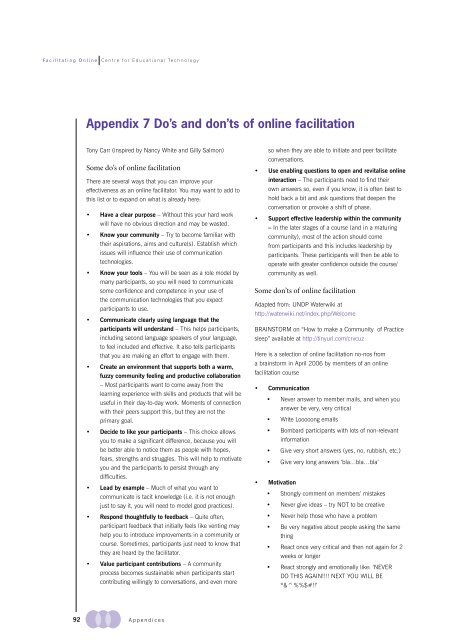Appendix 7 Do's and don'ts of online facilitation - Vula
Appendix 7 Do's and don'ts of online facilitation - Vula
Appendix 7 Do's and don'ts of online facilitation - Vula
- No tags were found...
Create successful ePaper yourself
Turn your PDF publications into a flip-book with our unique Google optimized e-Paper software.
Facilitating OnlineCentre for Educational Technology<strong>Appendix</strong> 7 Do’s <strong>and</strong> don’ts <strong>of</strong> <strong>online</strong> <strong>facilitation</strong>Tony Carr (inspired by Nancy White <strong>and</strong> Gilly Salmon)Some do’s <strong>of</strong> <strong>online</strong> <strong>facilitation</strong>There are several ways that you can improve youreffectiveness as an <strong>online</strong> facilitator. You may want to add tothis list or to exp<strong>and</strong> on what is already here:• Have a clear purpose – Without this your hard workwill have no obvious direction <strong>and</strong> may be wasted.• Know your community – Try to become familiar withtheir aspirations, aims <strong>and</strong> culture(s). Establish whichissues will influence their use <strong>of</strong> communicationtechnologies.• Know your tools – You will be seen as a role model bymany participants, so you will need to communicatesome confidence <strong>and</strong> competence in your use <strong>of</strong>the communication technologies that you expectparticipants to use.• Communicate clearly using language that theparticipants will underst<strong>and</strong> – This helps participants,including second language speakers <strong>of</strong> your language,to feel included <strong>and</strong> effective. It also tells participantsthat you are making an effort to engage with them.• Create an environment that supports both a warm,fuzzy community feeling <strong>and</strong> productive collaboration– Most participants want to come away from thelearning experience with skills <strong>and</strong> products that will beuseful in their day-to-day work. Moments <strong>of</strong> connectionwith their peers support this, but they are not theprimary goal.• Decide to like your participants – This choice allowsyou to make a significant difference, because you willbe better able to notice them as people with hopes,fears, strengths <strong>and</strong> struggles. This will help to motivateyou <strong>and</strong> the participants to persist through anydifficulties.• Lead by example – Much <strong>of</strong> what you want tocommunicate is tacit knowledge (i.e. it is not enoughjust to say it, you will need to model good practices).• Respond thoughtfully to feedback – Quite <strong>of</strong>ten,participant feedback that initially feels like venting mayhelp you to introduce improvements in a community orcourse. Sometimes, participants just need to know thatthey are heard by the facilitator.• Value participant contributions – A communityprocess becomes sustainable when participants startcontributing willingly to conversations, <strong>and</strong> even moreso when they are able to initiate <strong>and</strong> peer facilitateconversations.• Use enabling questions to open <strong>and</strong> revitalise <strong>online</strong>interaction – The participants need to find theirown answers so, even if you know, it is <strong>of</strong>ten best tohold back a bit <strong>and</strong> ask questions that deepen theconversation or provoke a shift <strong>of</strong> phase.• Support effective leadership within the community– In the later stages <strong>of</strong> a course (<strong>and</strong> in a maturingcommunity), most <strong>of</strong> the action should comefrom participants <strong>and</strong> this includes leadership byparticipants. These participants will then be able tooperate with greater confidence outside the course/community as well.Some don’ts <strong>of</strong> <strong>online</strong> <strong>facilitation</strong>Adapted from: UNDP Waterwiki athttp://waterwiki.net/index.php/WelcomeBRAINSTORM on “How to make a Community <strong>of</strong> Practicesleep” available at http://tinyurl.com/crvcuzHere is a selection <strong>of</strong> <strong>online</strong> <strong>facilitation</strong> no-nos froma brainstorm in April 2006 by members <strong>of</strong> an <strong>online</strong><strong>facilitation</strong> course• Communication• Never answer to member mails, <strong>and</strong> when youanswer be very, very critical• Write Looooong emails• Bombard participants with lots <strong>of</strong> non-relevantinformation• Give very short answers (yes, no, rubbish, etc.)• Give very long answers ‘bla…bla…bla’• Motivation• Strongly comment on members’ mistakes• Never give ideas – try NOT to be creative• Never help those who have a problem• Be very negative about people asking the samething• React once very critical <strong>and</strong> then not again for 2weeks or longer• React strongly <strong>and</strong> emotionally like: ‘NEVERDO THIS AGAIN!!!! NEXT YOU WILL BE*&^%%$#!!’92 Appendices
Centre for Educational TechnologyFacilitating Online• Tell everybody that your expectations will never bemet, that you don’t believe the group can succeed• Management• Never give deadlines, never define task <strong>and</strong> goals• No structured communication, no milestones,never define roles <strong>of</strong> each member, etc.• Give people very strict guidelines for contributionor long <strong>and</strong> complicated (<strong>and</strong> impossible)guidelines• Do not give enough time to contribute• Promise outputs/contributions, but don’t deliverAppendices93

















